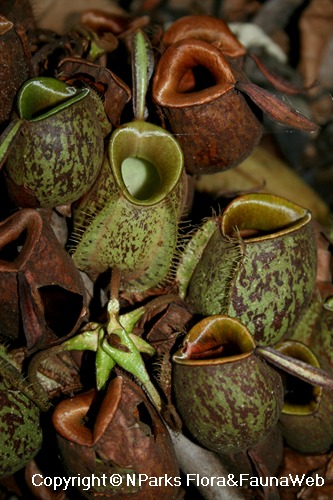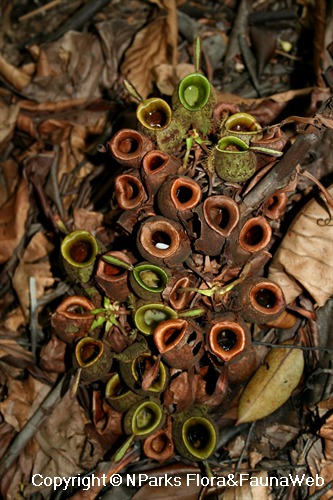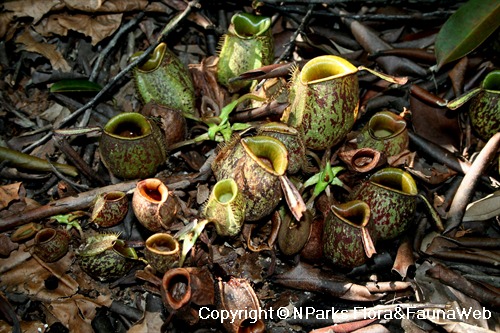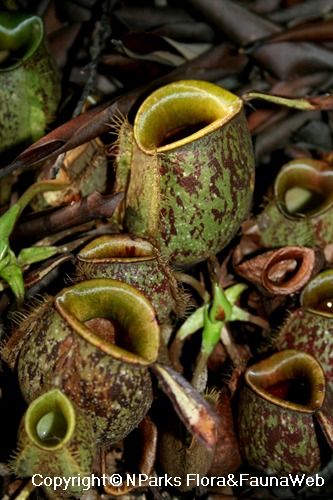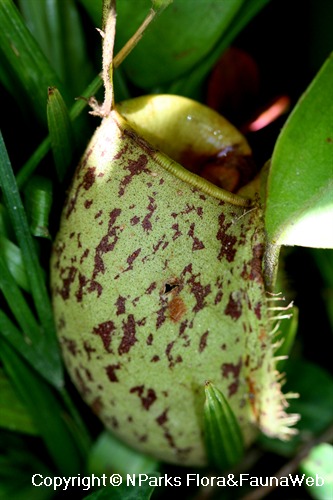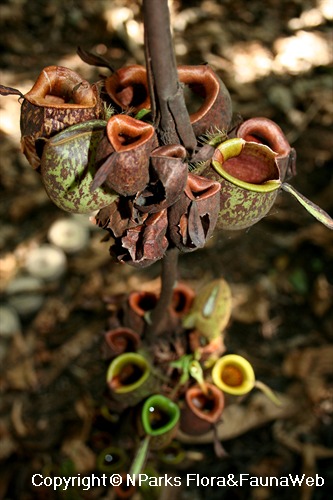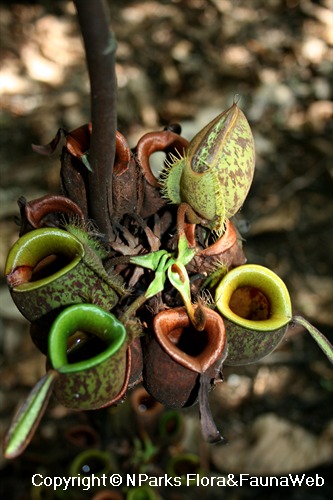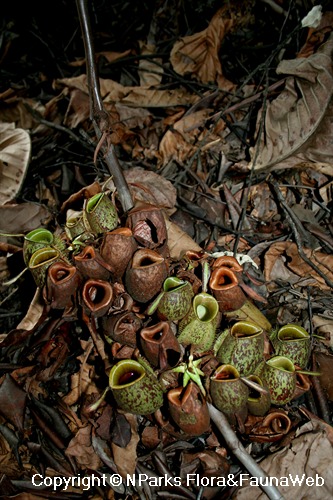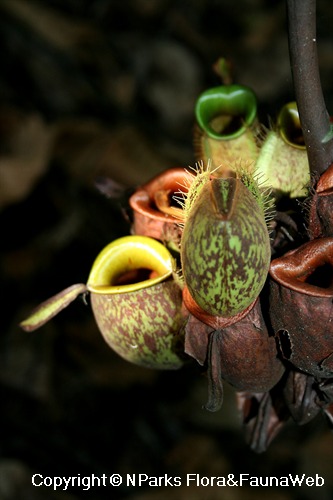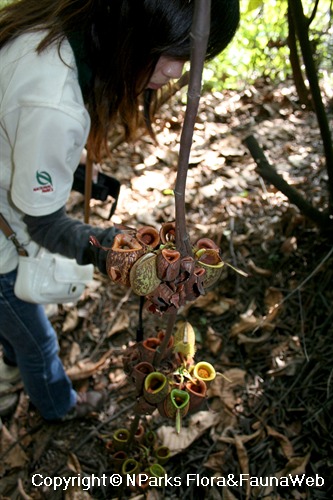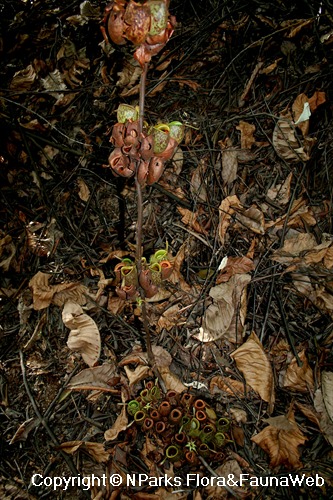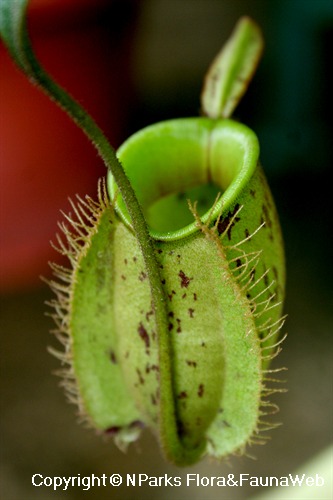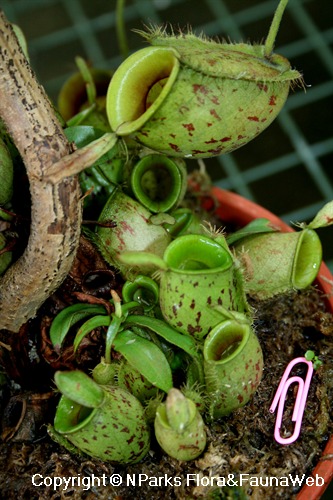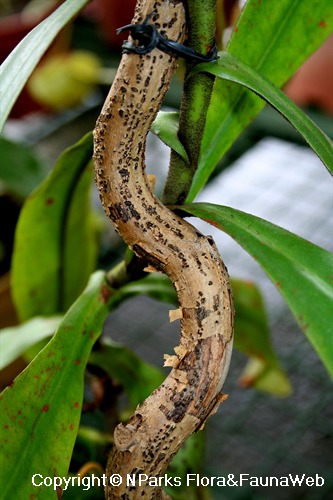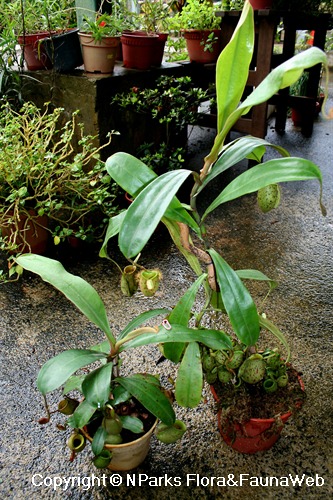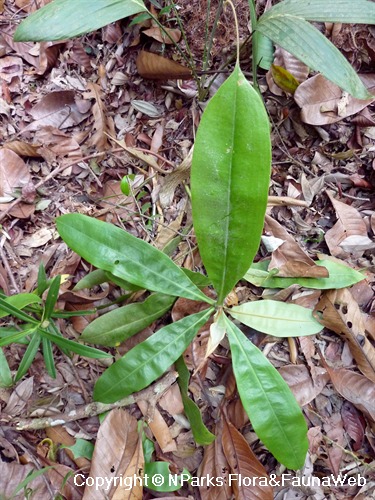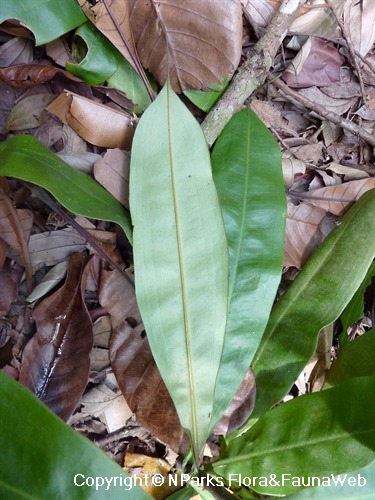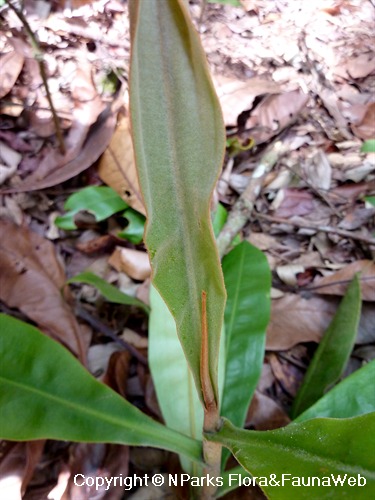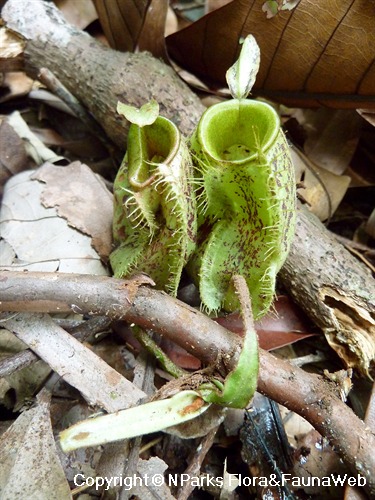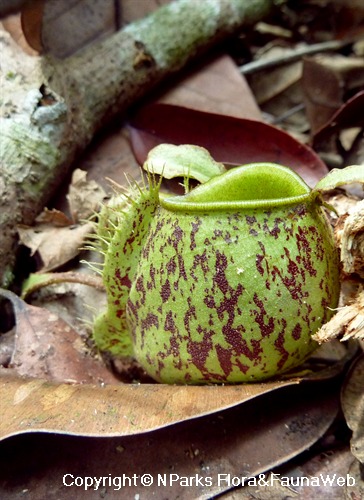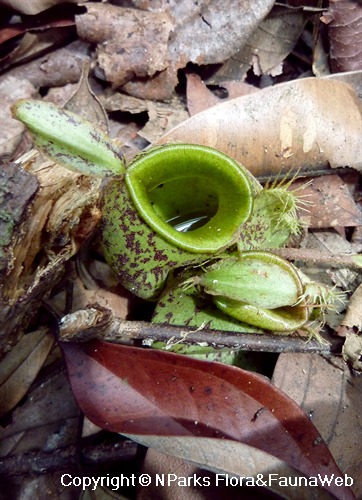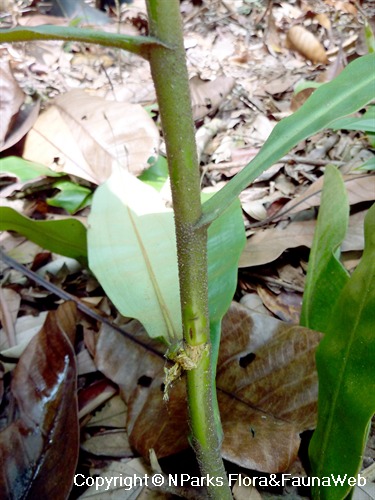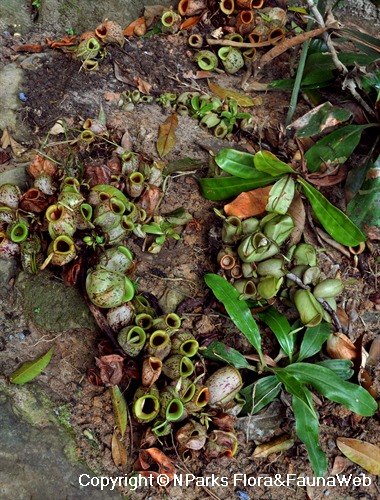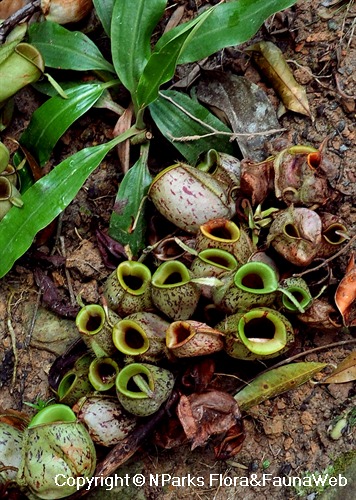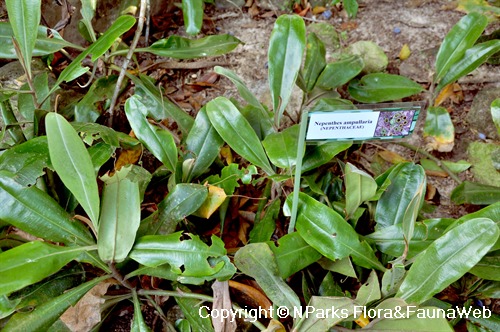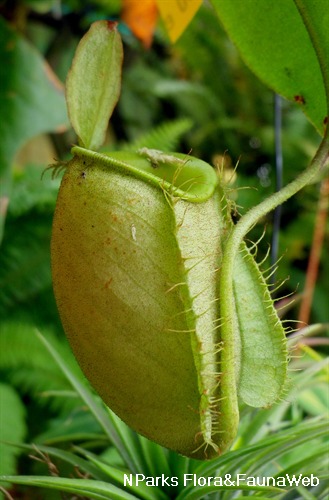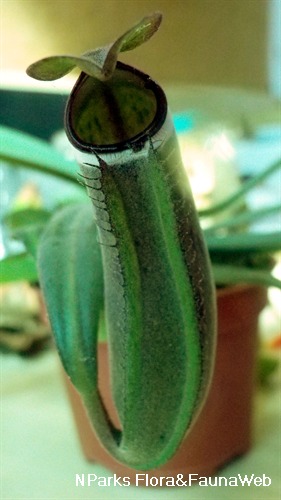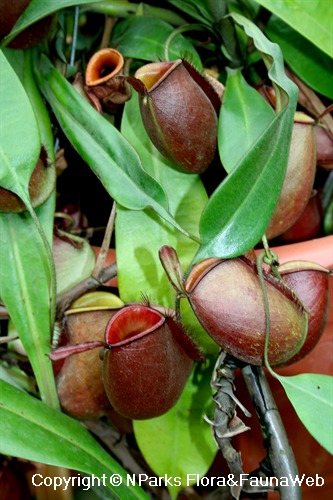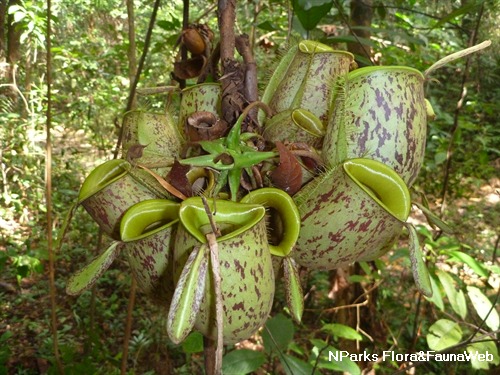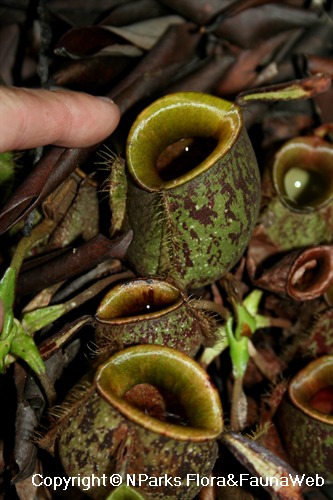
Back
Nepenthes ampullaria Jack (green-red speckled pitchers)
| Family Name: | Nepenthaceae |
| Synonyms: | Nepenthes ampullacea |
| Common Name: | Narrow-lid Pitcher Plant, Tropical Pitcher Plant, Periok Kera, 猪笼草 |
Name
Classifications and Characteristics
| Plant Division | Angiosperms (Flowering Seed Plants) (Dicotyledon) |
|---|---|
| Plant Growth Form | Climber, Herbaceous Plant, Creeper |
| Lifespan (in Singapore) | Perennial, Semi-Annual / Annual-Like |
| Mode of Nutrition | Autotrophic, Heterotrophic (Insectivorous / Carnivorous) |
| Plant Shape | Compact |
| Maximum Height | 6 m |
Biogeography
| Native Distribution | Thailand, Peninsular Malaysia, Singapore, Indonesia (Sumatra, Borneo), Papua New Guinea |
|---|---|
| Native Habitat | Terrestrial (Secondary Rainforest, Disturbed Area / Open Ground) |
| Preferred Climate Zone | Tropical |
| Local Conservation Status | Native to Singapore (Vulnerable (VU)) |
| CITES Protection | True (Appendix II) |
Description and Ethnobotany
| Growth Form | Herbaceous to semi-woody insectivorous vine, typically low-growing and prostrate, but able to climb up to 6m or more with support. Plant may exhibit annual-like behaviour and die down during dry season. |
|---|---|
| Foliage | Leaves oblong to spoon-shaped, sessile (stalkless), glossy green when mature, velvety reddish-brown when young. Leaf tips terminate in coiling tendrils, which under ideal conditions are modified into prey-catching pitchers. Plant forms sub-surface runners and off-shoots that give rise to carpets of basal rosettes spreading across forest floor, often half-buried amongst leaf litter. |
| Flowers | Plant is diocecious, with male and female flowers found on separate plants. Flowers small, yellow, clustered into panicle inflorescences up to 45cm across. Blooming occurs once or twice per year, lasting for several weeks. |
| Fruit | Explosive capsules, clustered into infructescences, maturing from green to brown, with lightweight threadlike seeds that are dispersed by wind. |
| Others - Plant Morphology | Conservation Status: Least common amongst the 3 Nepenthes species native to Singapore, less frequently sighted than the pure light green-pitchered form. Found locally in Kent Ridge Park, Central Catchment Reserves and Western Catchment forests. Categorized as 'Vulnerable' and currently threatened by habitat loss. Trade of plant controlled internationally by CITES II listing.Pitchers: Lower pitchers usually 5cm tall by 3cm across, speckled red on green background, globose and squatly urn-like, with short hairy keels on outer wall, and massed together side by side into basal rosettes. Pitcher lids atypically narrow and back-flipped, do not cover pitcher mouth (unlike those of other Nepenthes species). In nature, pitchers are partially filled with rainwater enriched with digestive enzymes secreted by glands on waxy internal wall. Well-adapted to intercept falling detritus from forest canopy, such as dead leaves and bird feces, and thought by some botanists to be evolving from a purely insectivorous to a mostly detritivorous diet. Upper pitchers found only on higher reaches of climbing stems, morphologically different from lower pitchers, usually pure green, narrowly funnel-shaped, often not upright, and contain no liquid or prey. Rarely developed and seldom observed, thought to be vestigal structures formed as a result of being plant being stressed by very poor soils. |
| Habitat | Distributed in tropical lowland peat swamp forests, secondary rainforests and other damp degraded areas with poor acidic soils. |
| Cultivation | Grows well under bright indirect sunlight. Requires high humidity, so if grown in air-conditioned areas, plant should be enclosed within a terrarium and misted occasionally. Prefers moist, poor-nutrient acidic media like peatmoss, sphagnum moss or salt-free cocopeat. Avoid fertilizing, especially with fast-release fertilizers, which may burn or kill the plant, or otherwise result in excessive foliage growth lacking in pitcher formation. Propagate by seeds (which may result in variable progenies), or stem cuttings. If taking tip cuttings, use 4-node cuttings (tip plus 3 lower leaves) to prevent tender growing tip from rotting before establishment. Single-node cuttings from lower parts of the plant are also possible. Basal rosettes joined by underground runners can be divided and potted up separately. |
| Etymology | Genus epithet 'Nepenthes' means 'no sorrow' or 'banished sorrow', based on the ancient Greek name of another plant that apparently relieves grief and produces euphoria, and used here in allusion to the reported medicinal qualities of some Nepenthes species. Species epithet ampullaria' means 'flask-shaped', a reference to the pitchers. |
| Ethnobotanical Uses | Food (Herb or Spice) Others: Medicinal: Plant contains gylcosides and phenols. In Malaysia, roots boiled and made into poultice to treat stomachaches and dysentery. Stem decoction drunk to relieve fever. Products: Climbing stems sometimes used for ropes or woven handicrafts. |
Landscaping Features
| Desirable Plant Features | Ornamental Foliage |
|---|---|
| Landscape Uses | Suitable for Hanging Baskets, Interiorscape/ Indoor Plant, General, Terrarium, Container Planting |
| Thematic Landscaping | Carnivorous Garden, Naturalistic Garden |
Fauna, Pollination and Dispersal
| Seed or Spore Dispersal | Abiotic (Explosive Dehiscence), Biotic (Fauna) |
|---|
Plant Care and Propagation
| Light Preference | Semi-Shade |
|---|---|
| Water Preference | Moderate Water, Occasional Misting |
| Plant Growth Rate | Slow |
| Rootzone Tolerance | Easy to Grow, Poor Infertile Soils, Acidic (low pH) Soils |
| Maintenance Requirements | Low |
| Pruning | Pruning usually not needed, unless to obtain stem-cuttings for propagation. |
| Fertilizing | Avoid fertilizing, especially with high-analysis fast-release fertilizers, as these may burn / kill the plant., or result in lots of foliage lacking in pitcher formation. If need be, use diluted strength of weak organic fertilizers (eg. orchid-type fertilizers, Osmocote). |
| Propagation Method | Seed, Stem Cutting, Division |
| Propagule Establishment Remarks | Pot cuttings up in nutrient-poor media, eg. salt-free cocopeat, peatrmoss or spaghum moss. Keep media moist and do not allow it to dry out. |
| Maintenance Requirements Remarks | If kept away from rain, try to fill the pitchers with rainwater up to half the pitcher's depth. |
| Propagation Method Remarks | If taking tip cuttings, use 4-node cuttings (growing tip and 3 leaves below) to prevent tender tip from rottting before establishment. Single-node cuttings possible from lower parts of the plant. Multiple basal rosettes can be divided by cutting underground runners. |
Foliar
| Foliage Retention | Drought / Semi-Deciduous |
|---|---|
| Mature Foliage Colour(s) | Green |
| Mature Foliage Texture(s) | Smooth, Glossy / Shiny, Leathery, Thick |
| Foliar Modification | Foliar Tendril, Pitcher Trap, Reduced / Needle-like |
| Foliar Type | Simple / Unifoliate |
| Foliar Arrangement Along Stem | Alternate |
| Foliar Shape(s) | Non-Palm Foliage (Oblong) |
| Foliar Venation | Parallel |
| Foliar Margin | Entire |
| Foliar Apex - Tip | Acute |
| Foliar Base | Truncate / Square |
| Typical Foliar Area | Microphyll ( 2.25cm2 - 20.25 cm2 ), Notophyll ( 20.25cm2 - 45 cm2 ) |
| Prominent Young Flush Colour(s) Remarks | Furry reddish-brown |
Non - Foliar and Storage
| Mature Bark Texture | Peeling / Flaking / Papery |
|---|---|
| Stem Type & Modification | Woody, Herbaceous, Runner / Stolon |
| Root Type | Underground (Fibrous Root) |
| Mature Bark Texture Remarks | Corky bark on woody stems |
Floral (Angiosperm)
| Flower & Plant Sexuality | Unisexual Flowers , Dioecious |
| Flower Colour(s) | Yellow / Golden |
|---|
| Flower Symmetry | Radial |
| Flower Size - Remarks | Small, held in inflorescence |
| Inflorescence Type | Panicle |
| Flower Lifespan on Plant | Several Days |
| Flowering Habit | Polycarpic |
| Flowering Period Remarks | Usually twice per year under local conditions |
Fruit, Seed and Spore
| Mature Fruit Colour(s) | Brown |
|---|---|
| Fruit Classification | Simple Fruit |
| Fruit Type | Dehiscent Dry Fruit , Capsule |
Image Repository
Others
| Master ID | 14756 |
|---|---|
| Species ID | 3330 |
| Flora Disclaimer | The information in this website has been compiled from reliable sources, such as reference works on medicinal plants. It is not a substitute for medical advice or treatment and NParks does not purport to provide any medical advice. Readers should always consult his/her physician before using or consuming a plant for medicinal purposes. |

